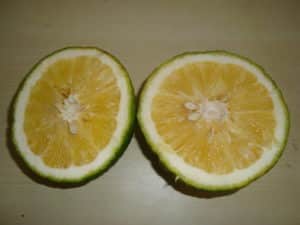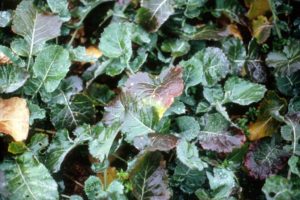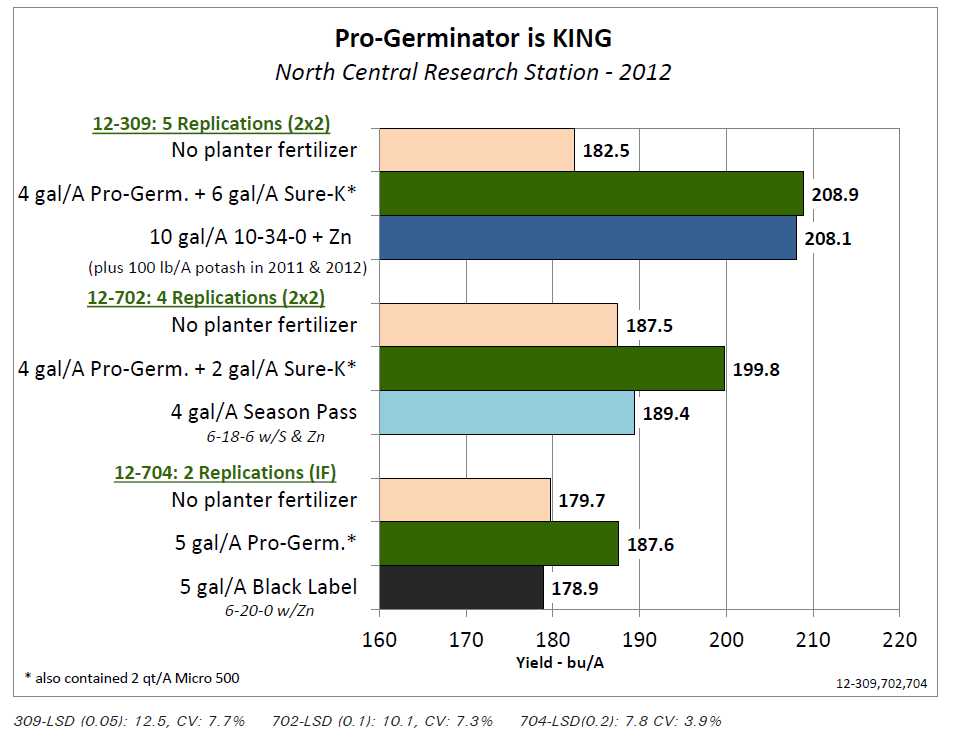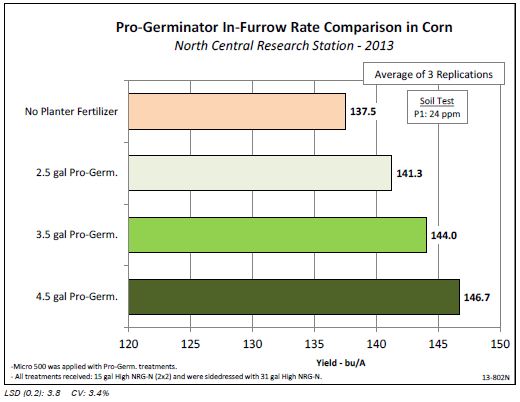Phosphorus is an essential nutrient for crops. Along with nitrogen and potassium, it’s one of the nutrients that plants need the most. It’s also a primary ingredient in many fertilizers. NPK fertilizers are among the most common for commercial crops and home gardens. Knowing how to use phosphorus fertilizer on crops, and knowing what to expect, can help you increase yields and get the most out of your fertilizer program. Let’s take a look at how to use phosphorus fertilizer on crops. We’ve updated this post in 2022 to give you even better information and help make it easy to manage your crops.
How to Use Phosphorus Fertilizer on Crops
In this blog post, we’ll take a look at some of the ways to use phosphorus fertilizer on crops, and how to maximize yields. We’ll take a look at our own phosphorus fertilizer product, Pro-Germinator, in particular. You can take a look at the research we’ve done on corn and soybeans to see how we’ve maximized our yields with phosphorus fertilizers.
Optimize phosphorus fertilizer on your crops
Learn more about Pro-Germinator >
Why Is Phosphorus Important to Crops?
Phosphorus may not be first in the N-P-K lineup, but don’t underestimate its importance to plant growth and development. Many essential plant processes would not occur without it. There is no substitute for phosphorus if your primary goal is to maintain first-rate crops and high yields.
Every living plant cell contains phosphorus as part of the substances that carry the DNA code of living things. It is a vital component of DNA and RNA, the building blocks of proteins and protein synthesis. The adenosine triphosphate molecule (ATP) molecule is responsible for storing and transferring all of the energy produced and needed by the plant. At the core of this ATP molecule are phosphates, responsible for all of the activity of ATP.
Phosphorus is an essential plant nutrient and very important for numerous plant processes and crop production. Phosphorus directly influences reproduction, photosynthesis, cell division, root development and energy storage. Some flowers and fruit also contain high concentrations of phosphorus. Phosphorus also speeds up plant maturity and promotes seed production. It also increases water use efficiency and contributes to disease resistance.
How Phosphorus Deficiencies Look
The older leaves of your crop will be affected first by a phosphorus deficiency, with leaves taking on a darker green or purple color. Plant growth will also generally be stunted causing plant maturity to be delayed. In severe cases, a phosphorus deficiency will cause plant leaves to curl upward.
Common phosphorus deficiency symptoms:
- Stunted plants
- Leaves may be darker green or begin purpling
- Leaves may curl upward
- Maturity can be delayed
- Poor seed set
- Poor fruit quality
Problems Using Phosphorus Fertilizer on Crops
Our crops clearly need phosphorus to thrive. So, what do we need to worry about when using phosphorus fertilizer? “Tie up” within the soil is the primary concern with phosphorus fertilizers. In acidic soil conditions, phosphorus will tend to get tied up by iron, aluminum, and manganese. In basic soil conditions, calcium will be the major component of phosphorus tie up.
Pro-Germinator doesn’t get tied up in soil
Learn more about Pro-Germinator >
How Phosphorus Fertilizer Gets Tied Up in the Soil
In any given year, crops take up a combination of phosphorus applied in the current cropping year and phosphorus applied in previous years. Soil pH or acidity influences phosphorus reactivity and determines the speed and type(s) of insoluble phosphorus that is most likely to form.
Phosphorus fertilizers are generally very inefficient and only a small portion of what is applied typically gets into the crop. Estimates are that the crop will utilize only around 20% of applied phosphate fertilizer during the season after application, and in following years, the amount becomes progressively less as it reverts to mineral forms.
Phosphate is negatively charged and can react with, or be fixed, by positively charged elements in the soil (cations). Plants cannot take up these compounds, like calcium phosphate, aluminum phosphate or iron phosphate.
Phosphorus is most available to the plant in a soil pH range of 6.3-6.8. Common liquid fertilizers, such as ammonium polyphosphate (10-34-0) and orthophosphate (9-18-9), applied in the early spring will also have a likely chance of being tied up if a gypsum application was made in the fall.
Choosing a phosphorus fertilizer that is protected from tie up will ensure that you get the most out of your fertilizer investment and that your crop will receive the required amount of phosphorus needed.
Placement of Phosphorus Fertilizer is Key
Correct placement of phosphorus near the root zone is crucial because of its low mobility in the soil. The greater the distance the root must cover to reach the phosphorus, the greater the chance it will be unavailable when the plant needs it. Most plant roots only explore about 3% of the soil around them. Stunted growth, spindly stalks, distorted leaves and purpling are all signs of a phosphorus deficiency, as well as reduced blooms and/or onset of fruit.
Phosphate fertilizer works best if it is placed close to the seed at planting. In the picture at the left, it is apparent that phosphate fertilizer placement is affecting growth. Five rows of the plot had 5 gal/A of Pro-Germinator applied through the planter, and the sixth row had no planter fertilizer.
Fertilizer placement comparison using Pro-Germinator in corn
The rows with the In-furrow placement are tasseling, whereas the 2×2 placement has yet to tassel. Close inspection shows that the corn with the 2×2 placement is taller than the row with no fertilizer, but it is behind the rows with the in-furrow placement. This shows that phosphorus placement for earliest root access affects plant growth and yield. Additional testing at the North Central Research Station has shown that in-furrow placement can out-yield 2×2 placement by almost 5 bu/A.
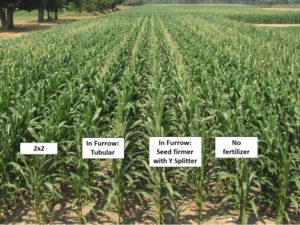
How Does Pro-Germinator™ Phosphorus Fertilizer Prevent Tie-Up?
Pro-Germinator™ utilizes carbon as a building block to form long phosphorus chains that provide protection for the nutrient until the plant is ready to absorb it. The phosphorus compound isn’t subject to movement from the cropping environment because it reaches its intended destination the first time. This creates an optimum situation and leads to greater use efficiency.
The following experiments show how Pro-Germinator phosphorus fertilizer compares to other fertilizer types, and how it can maximize yields.
Comparing Phosphorus Fertilizer Programs
Experiment Info
| 309 / 702 / 704 | |
| Planted: | 4/19, 24, 19 |
| Variety: | DKC53-75 |
| Population: | 36,000 31,000 31,000 |
| Row Spacing: | 30″ |
| Previous Crop: | Soybeans |
| Plot Size: | 15×18’/210’/130’ 15’ x 265’, 15’x265’ |
| Replications: | 5, 4, 2 |
| Sidedress: | 5/23 |
| Harvested: | 10/22,26 11/5 |
Soil Test Values (ppm)
| pH: | 7.3, 6.1, 6.2 |
| CEC: | 6.5, 12.3, 12.4 |
| % OM: | 1.8, 3.5, 2.7 |
| P1: | 26, 20, 16 |
| K: | 76, 203, 151 |
| S: | 11, 9, 8 |
| % K: | 3.0, 4.2, 3.1 |
| % Mg: | 16.4, 13.7, 16.2 |
| % Ca: | 79.6, 67.4, 68.4 |
| % H: | 0, 14.1, 12.0 |
| % Na: | 1.0, 0.6, 0.3 |
| Zn: | 1.0, 2.0, 2.3 |
| Mn: | 4, 14, 8 |
| B: | 0.6, 0.5, 0.5 |
Objective:
Comparison of different sources of planter time fertilizer to Pro-Germinator for yield effect on corn.
Each season the NCRS gets questions on how various other phosphorus containing planter time fertilizers compare to Agro-Culture Liquid Fertilizers Pro-Germinator. In most experiments at the NCRS a conventional fertilizer source is included for comparison. The data below shows three different experiments comparing Pro-Germinator to a conventional product. In each of these experiments a different outside source of phosphorus fertilizer was used. The three products compared to Pro-Germinator were: 10-34-0, Season Pass (6-18-6 w/S and Zn) and Black Label (6-20-0 w/Zn). Fertilizer rates, placement (in-furrow or 2×2) and yield results appear on the chart below.
- All fertilizer sources significantly increased corn yield over the no planter fertilizer treatments.
- Pro-Germinator yielded significantly higher than both Season Pass and Black Label. (Note: Season Pass was applied at manufacture suggested rate of 4 gal/A).
- There was no difference in yield between programs of Pro-Germinator and 10-34-0. Potassium as Sure-K can be applied along with the Pro-Germinator, while muriate of potash is a separate application with 10-34-0.
- As shown in past years of research, Agro-Culture Liquid Fertilizers’ Pro-Germinator yields similar to and often out performs other sources of phosphorus planter fertilizer.
Pro-Germinator In-Furrow Rate Comparison in Corn
Experiment Info
Planted: 5/9
Variety: P0216HR
Population: 31,500
Row Spacing: 30”
Previous Crop: Corn
Plot Size: 15’ x 530’
Replications: 4
Sidedress: 6/15
Harvested: 10/22
Soil Test Values (ppm)
pH: 6.1
CEC: 10.8
% OM: 2.4
Bray P1: 24
K: 128
S: 10
% K: 3.0
% Mg: 18.5
% Ca: 63.7
%H: 14.4
% Na: 0.4
Zn: 0.9
Mn: 9
B: 0.4
Objective:
To compare in-furrow rates of Pro-Germinator in Corn. Pro-Germinator is a highly effective nutrient product delivering both ortho and poly forms of phosphorus, giving plants an early and steady availability. An in-furrow band application provides nutrients where they are needed most. Pro-Germinator is balanced with nitrogen, potassium and micro nutrients for excellent performance. This experiment tested increasing rates of Pro-Germinator to see its results on corn yield. A no planter fertilizer treatment was used for comparison. Rates of 2.5, 3.5 and 4.5 gpa were used as treatments along with Micro 500 at a rate of 2 qt/A in each treatment. With the high soil test value of 24 ppm of P1, the recommendation for this would be 2.5 gpa in-furrow for a yield goal of 175 bu/A. Yield results appear in the chart below.
Conclusions:
• Growing conditions were very dry into the growing season as such, we did not reach our yield goal. But there was an increase in yield as the rate of Pro-Germinator was increased.
• All three rates of Pro-Germinator had a significant yield advantage over the no planter fertilizer treatment.
• Data confirms, along with past research, that even in higher phosphorus soils, there is a benefit of 3-4 gpa of Pro-Germinator planter applied.
• It is likely that the Pro-Germinator increased root volume that enabled better yield in the dry growing conditions.


